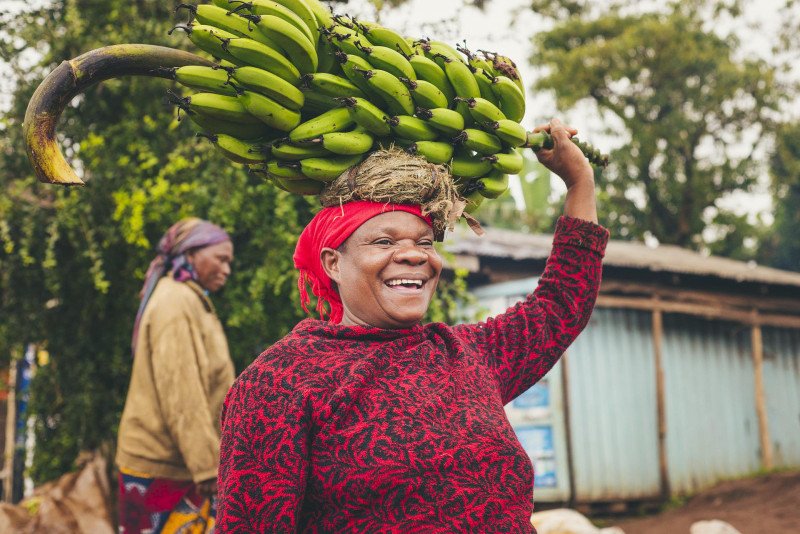One of the articles that appeared in the July edition of this magazine asked the question on whether Africa will ever be rich or will ever develop. Before its conclusion, the article listed ten internal challenges or barriers that must be resolved to pave the way for Africa’s movement to richness and prosperity. Diagnosis of problems is necessary to provide the opportunity for planning various solutions and their implementation strategies.
This article adds another slant as a further step to be taken after the preliminary steps starting with identification of challenges. The slant is that in all things, there is the need for preliminary introspection; asking questions on the role one played for the barriers and challenges to emerge in the first place; secondly, asking questions on the preparedness of the individual, society or country to counter the effects of existing challenges; and thirdly making plans and marshalling resources to keep the development process in constant motion.
The slave trade was abolished at various times in the nineteenth century, not because of philanthropy or charity. Certainly, the voices of abolitionists such as Lord Mansfield and Granville Sharp of Britain and many others in America and Europe played a part in the abolition of slavery. The slave revolts in the Caribbean, on the plantations in North America and in the mines of South America also played significant part in the abolition.
However, the slave trade was abolished mainly for economic and commercial reasons. The first industrial revolution started officially in 1750 ending in 1850. Within the hundred years, and in the immediate years thereafter, work machines such as the following were invented: Textile mills (1769); the cotton gin (1794); the steam ship (1819); the combine harvester (1826 in Scotland and 1836 in the USA); the railway (1825); the telephone (1876). The farm tractor had gone under many changes and the mechanized one invented in 1889. Many of the factories in the metropolitan countries that needed these machines for production had also been built and were in operation.
In essence, most of the manual jobs for which African slaves were needed had been mechanized, making African slaves essentially redundant in Europe and America. At this point in time, what was needed were raw materials for processing into finished goods in the factories of Europe and America. The slave trade therefore had to be abolished and Africans assigned to new responsibilities of providing the raw natural resources needed for industrial production: Crops and mineral ores from lands and mines in their own countries.
In Africa itself, local slave traders who sold slaves to European slave traders for shipment overseas, could not understand why the slave trade had been abolished. Together with the European slave merchants, they put up the resistance of finding subtle ways for shipping slaves in rogue slave ships.
The local African slave traders and the European slave merchants did not see the abolition correctly. They were aggrieved that their source of income had suddenly been abolished. Both African slave traders and their European partners could not see that Europe and America were moving to the next two sectors of production: manufacturing and services. African slave traders did not have a plan for the next stage after the abolition of slavery. Their lives were tied up with slavery with no other plan for work and development.
The resistance to the abolition by the African slave traders and their European slave partners was therefore a nuisance and a direct confrontation with the European powers. The British consequently had legislation passed that allowed them to arrest ships carrying slaves on the high seas, release the slaves and repatriate them to their homelands.
The Berlin Conference: 1884-85
Abolition of the slave trade was a planned and well-calculated economic and commercial initiative. To make the initiative work to perfection, the areas of Africa where slaves were procured, had to be demarcated, shared and mapped by the European powers to whom sectors of the African continent had been allocated at the Berlin Conference of November 1884-February 1885. By the year 1900, most of the African continent had been partitioned and put under colonial administration. It was from such agreements that most of modern African nations were carved out by European powers; and not by Africans themselves. Despite boundary problems, most of Africa became the beneficiaries of the nations that came into existence by 1900.
Every step toward implementation of the primary, secondary and tertiary production model had a purpose. The Berlin Conference had the purpose of giving legitimacy to the partition of Africa into exclusive colonies for European powers. Under the colonial system, the new European administration could then oversee the primary production and export of natural resources from Africa, and other colonies, to Europe and America.
Colonial economy
The plan of European powers was to put into effect the three stage model of production. Africans were required to stay in their home lands, produce the raw materials needed at the primary segment of production and export such materials overseas for manufacturing goods in European and American factories.
The word “economy” may be defined as the structure, organization and finance of goods and services produced in a community or in a country in a period of time, mostly in a year. The goods in this definition includes primary natural resources, but mostly refers to manufactured finished or semi-finished products in the metropolitan countries from raw materials imported from Africa and other colonies.
In a colonial economy, the primary production of low-price natural resources is assigned to African colonies and other overseas colonies while the high-price secondary and tertiary production sectors consisting of the manufacturing of finished goods takes place in factories of the metropolitan country. At the third stage, finished goods are then shipped to markets in the colonies. A colonial economy is therefore an economy that mainly produces and supplies primary natural resources for export to factories in the metropolitan countries.
Before the United States got its independence from Britain in 1776, the American economy was a colonial economy; and before India gained its independence from Britain in 1947, the colonies of India operated colonial economies. Many countries including Australia, Canada, New Zealand and the Caribbean islands have earlier been colonies of metropolitan countries such as Britain, France, Spain and the Dutch.
Colonial economies were export-import oriented and looked like the diagramme below:
The colonies directly shipped low-price natural resources to factories in the metropolitan countries, while the metropolitan factories shipped high-price finished-manufactured goods to the colonies for sales. From the areas of Guinea, Cote d’Ivoire, Ghana and Nigeria in West Africa, the following natural resources were produced and exported to factories in Europe and America:
- Cocoa
- Coffee
- Bauxite
- Fish (frozen)
- Palm oil
- Peanuts
- Rubber
- Timber
- Sorghum
From Central Africa and Southern Africa, the following resources were exported:
- Cocoa
- Copper
- Cobalt
- Diamonds
- Gold
- Sugar
- Timber
- Wool
From Eastern Africa, the following natural resources could be obtained:
- Coffee
- Beef
- Flowers
- Tea
Secondary production
What the British colonial power for instance, needed to do under the colonial business climate was to provide the necessary infrastructure in the colonies to facilitate the movement of natural resources from the mines and commercial farms for export to Europe. A telephone system had to be installed; road construction had to start; railway system had to be constructed especially toward the end of the 19th century. The first banks in the colonies were set up at the end of the 1800s and motor cars introduced in the years 1902-1910.
From the primary minerals, crops and timber imported from African colonies, butter, margarine, soap, cooking oils, furniture, tooth brush and tooth pick, chocolate, aluminium cups, pans and roofing sheets, iron rods for building, jewels, clothes made from cotton and wool from Africa and other countries were manufactured in Europe and America, exported and sold in shops all across the African continent and in other overseas countries.
Tertiary production
The third production stage was to market and sell the finished goods manufactured in Europe and America in shops in Africa and in other overseas colonies. This was the time in which Multinational Corporations set up large businesses and shops in the countries of the continent. This was also the time when many of the private sector businesses mostly dominated by foreign companies emerged.
Commodities and their value
All the raw materials obtained in Africa for export mentioned above are commodities. Commodities are raw natural materials required for processing into finished or semi-finished goods. Commodities are low-value items whose prices change each day. The price of cotton changes each day; the price of each of the items obtained from the African colonies changes every day. Commodities are all items exploited from nature; from inside the Earth or from the land and forests of the Earth. Commodities have variable prices and variable demand pattern. Independent African countries are still operating the colonial economy; the type of economy which the European powers assigned to Africa by the close of the Berlin Conference. Commodities alone can never make Africa rich.
Poverty of former colonies
The colonial economy system was put together to allow factories and businesses in the metropolitan countries to obtain the following advantages:
- Cheap raw materials from the colonies
- Cheap labour in the colonies
- Large markets in the colonies
Businesses in the metropolitan countries imported cheap natural resources from the colonies and exported high price manufactured goods for sale in the colonies. The metropolitan countries had a plan before or just about the time of the abolition of the slave trade. African countries did not have a plan.
The result of current African colonial economies is that it made and still makes factories and other businesses in the metropolitan countries richer while keeping the colonies poorer. The Nigerian legislator, Audu Ogbeh, makes the following statement in a video titled: “The Tragedy of Nigeria”
“The tragedy,” the legislator says, “started with the structural adjustment programme recommended to the Nigerian government by a team from the World Bank and Harvard University in1983. The programme required weekly devaluation of the Nigerian naira for 32 years, leading to poverty, misery and increases in bank interest rate; making it impossible to build factories, farms and undertake any meaningful development projects to create employment.” The legislator goes on:
“Every time you bring in a shipload of rice, you also bring in a shipload of unemployment.”
The legislator continues: “18 million US dollars worth of tooth pick and 400 million US dollars worth of tomato paste are imported into Nigeria every year. He states that items such as milk, sugar, pencils and handkerchiefs are all imported into Nigeria and it is difficult to stop such imports because when you make an attempt to stop such imports you make enemies both locally and externally who will stop at nothing to hold on to their source of wealth.”
What the legislator is lamenting about is not happening only in Nigeria. It is happening all over the African continent. The major portion of the economies of African countries is controlled by overseas manufacturers and exporters in alliance with local African importers.
The sad fact is that Africa is still operating the colonial economy system and has no plan for moving to a new and modern economic model. Almost everything is imported from overseas countries. The UN Economic Commission’s “Compact for Africa’s Recovery’ as well as the efforts of the New Partnership for Africa’s Development (NEPAD) do not seem to have made any significant impact on the colonial economy of African countries.
When the Portuguese first arrived in Africa in the 15th century, they brought manufactured goods. They brought the following:
- Jewels
- Leather belts
- Shoes
- Wooden chests
- Alcoholic drinks
- Chamber pots
These were rudimentary manufactured items; but at least they were items that had gone through manufacturing machinery at that time in history.
Secondary production has started in many African countries but this production is mainly limited to light industrial items such as:
- Textiles
- Sandals
- Soaps
- Leather belts
- Wooden planks
- Wheelbarrows
- Soft drinks
- Alcoholic drinks
Most other items from modern secondary production are imported from European countries, from America or from China. What is really the point in importing tomato paste, sugar and toothpick: very basic things that can easily be produced in any country on this continent?
What the African continent needs is structural change -not the “structural programme” imposed on Nigeria in the 1980s. African countries should prepare to get out of the colonial economy malady by utilizing the natural resources they export as the bases for practice in industrialization, and in the process build up adequate financial leverage to minimize external borrowing, and further build the power to fight internal barriers, challenges and threats that thwart the development progress of the continent. It is through such process that the continent will be able to reach its richness and prosperity.
The simple message is that,
The courageous and inventive
shall always rule over the timid;
and the bold shall always win the prize.
Sources
- https://oec.world >profile>country>cmr
- https://www.ifpri.org >structural-change
- https://dx.doi.org/10.2499/9780896292147-ch4
- https://www.twinki.com >teaching-wiki
- https://www.hydropower.org >iha>discover-history-of-hydropower
- https://ironsolutions.com> a-brief-history-of-the-combine
- https://en.wikipedia.org > New-Partnership-for-Africa’s…
- https://www2.gwu.edu >Jedwab_IIEPWP2012-12
- UN Economic Committee report on “Compact for Africa’s Recovery”












